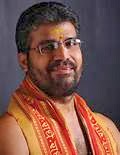The Process of Yoga : 3-4. Swami Krishnananda.
=========================================================================
Chinmaya Mission :
The whirlwind visit by Pujya Swami Swaroopananda to Chinmaya Mission Manila that concluded today was enlightening and fun-filled with beautiful memories.
Pujya Swamiji gave guidance to all on how to bring positive changes in our thought patterns enabling us to remove any negativity, fear or panic by challenging the unknown and going through uncertainty with a smile.
The Balavihar students entralled all with their beautiful presentation on the Ramayana.
Do invite your friends and family who live in Manila to visit the new Chinmaya MIlan centre recently inaugurated by Pujya Swamiji and register for regular classes.
=========================================================================
Tuesday, November 29, 2022. 06:00.
Chapter 3: Recognising the Independent Status of Things-4.
=========================================================================
Likewise, when we begin to see an object we make the assertion, “I see the object.” Now, seeing is nothing but a state of experience or an operation of consciousness. Unless our consciousness operates, seeing and knowing are impossible. If we know the existence of an object in front of us, it means there is consciousness operating in front of us. What we are conscious of is not the object as such, but the operation of our own consciousness in respect of the object.
In philosophical terminology, we are given a description of the process by which we become aware of the object outside. Similar to the comparison that I gave of the relation between the sunlight and the object that it illumines, we may apply this analogy to the perception of an object. Just as the light of the Sun falls on the object, our consciousness proceeds from us and falls on the object, envelopes it, and takes its shape, in the same way that sunlight may be said to take the shape of the object in order that it may become an object of perception or knowledge. Our consciousness goes outside through space and in time, envelopes the object, and makes it shine.
Now, this shining is different from the shining of the object by the light of the Sun. We can conceive of an object even by closing our eyes. We can have mental objects, as we have physical objects. The process of perception is, therefore, purely a consciousness process. The movement of our own intelligence begins through an invisible process of activity in the medium of space and time, all which is on account of the fact that the object outside and the subject within have come from the same source.
Yoga practice is the name that we give to the process of this coming together of the object and the subject, and the experience of the subject in relation to the object in the manner in which it would have been had the experience been given to us at the point of creation itself. This is what the Yoga Sutras of Patanjali, for instance, mention as the establishment of consciousness in itself – tadā draṣṭuh svarūpe avasthānam (1.3). The establishment of consciousness in itself is only a name that we give to the process of the return of the object to itself as pure subjectivity in its universal connotation.
Samsara, or earthly existence, the world of pleasures and pains, is the world of tensions created by the reaction between the subjects and the objects. To judge an object as it is, is different from the way in which we judge an object as it appears to us. When we look at an object, we do not look at the object as it is. The object means something to us. The meaning that we read in an object disturbs our correct apprehension of the object. We can never see an object as it is by itself. When we look at a tree, we see it as our tree or not our tree, as a tree in our garden or a tree in somebody else's garden, or a weed that grows in our field, and so on. We look at a person as our friend or not our friend, as related to us positively or negatively, as known to us or unknown to us, and so on. Whenever we look at things, we project a personal relationship in respect of them, and cannot look at a thing as it is in itself – just as, as I mentioned a few minutes before, we are a different in ourselves from the way in which we look or appear to others.
This rule applies to every object. If we can learn to look at things as they are rather than look at them in the way in which they appear to our minds due to the predisposition of the mind, we would be independent in the real sense of the term. That is called svarajya, or independence, which is the mastery that we gain over our mind rather than social acceptance of it in a tentative manner.
*****
To be continued
=========================================================================








.jpg)



Comments